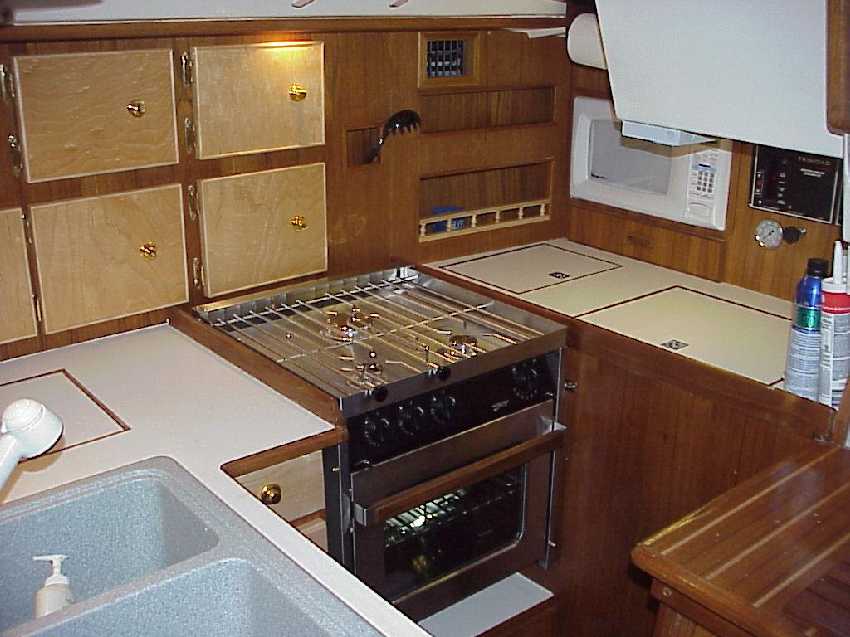
66.
An hour later, the new stove looked like this. It's a Force 10 with broiler. It replaced that old, original Force 10 we installed when the boat was new. We stayed with this model because of two advantages; It has the disappearing door that really helps in this size galley and it is the same size as the old stove so it took less that an hour to install this one.
Note the watermaker next to the microwave. THE REASON THIS BOAT WORKS doing what we did with it, is because of the watermaker. Very limited tankage allowed us to carry more of the essentials like FOOD and tasty adult beverages and FUEL.
I should also point out the racks between the microwave and the cabinet doors. That's them against the hull. They serve as a condiment/spice rack. Also behind them is a conduit for the heater duct, propane hose and shut off and plumbing passage for the stern shower and tank fill from the water maker. That cooking utensil receptacle above the stove was a bonus. The space just happened to be 'a natural'. No more lashing our cooking utensils to the knife block.
The outboard freezer and the 'fridge have drains that are hooked to a common pipe that continues past the bilge to the shower sump. I did this for several reasons. First, the bilge, where the factory located this drain, is a terrible place to send this type of material. Also because we send the bilge pump water out of the stern, I didn't want that potentially smelly stuff back-flowing past the checkvalve. And flushing the bilge with water, fresh or salt, is a pain. I have a 'dry bilge fantasy'. Lastly, the shower sump is much easier to flush and keep clean.
As far as retrofitting insulation in sister ships, I posted this text online.
First, inside the engine box, peel back any sound proofing. (Joke, the stock stuff is junk) Then install a layer of closed cell foam where the ice box is against engine heat. The best solution is to mount a vacuum panel there. But the problem with that is it would be exposed to any nicks or dings and would loose vacuum. If that happened, it's ruined. It would go from R36 to R2. I mounted mine on the inside of the panel. Better stick with closed cell foam in the engine box.
Then for the bottom, at the rear of the box where the factory mounted the batteries, (bigger joke) drill a 1/4" hole. You are looking for AIR, not foam. Then do the same thing in the opposite side at the front-bottom. You know, in that space under the stove area. Again, you're looking to find air. Also make a couple of holes in the wall of the trash bin. Then go to Home Depot and buy about 6-8 cans of insulating spray foam. They should be all over the store. Stick a nozzle in the low-rear hole and start filling. Don't stop until you see foam coming out of one of the holes under the stove. It should then expand to the hole in the trash bin and vent out to an unobtrusive area for cleaning AFTER it dries. I would also cover the area around the holes with duct tape so that the foam can't penetrate wood grain. Also plug the lower holes as soon as foam is there. It really helps with cleanup too. I would also caulk the gap at the floor in the galley prior to this job. You could just tape it,,Na, caulk it.
At the rear of the box, when you're done spraying foam, you can make a template of the rear panel and install another foam panel. You can order up a vacuum panel from rparts.com but, again, it must be protected.
The way we did this job is to buy four gallons of pour foam and build it up from the front with the front panel off. The entire area was covered with vis-queen to prevent disasters. I wouldn't use the stuff again. Too hard to work with. Just use the spray stuff.
Now look under the lid inside the box. Don't see any insulation do you? And these are Florida boats! Again, foam boards with spray adhesive works. Another trick with the foam boards is to cut them just a little larger than the space available and then wedge them into place.
Our refer holdover plate only requires the engine to pull it down once a day for 30 minutes because the freezer is next to it and outboard. The freezer is pulled down twice a day. On my to-do list is adjusting the freezer TXV for more volume. It's still a little light. I might also change it to a higher tonnage.